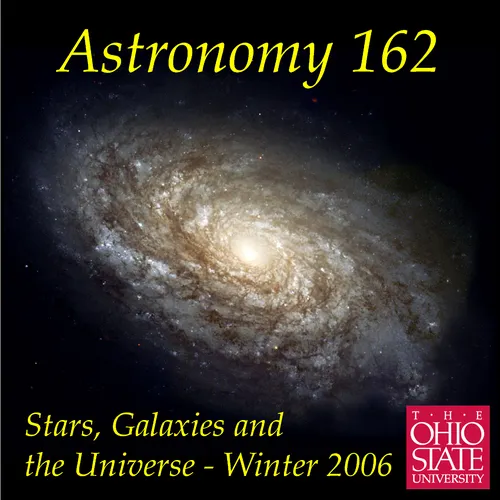
Astronomy 162 - Stars, Galaxies, & the Universe
Astronomy 162, Stars, Galaxies, and the Universe, is part 2 of a
2-quarter introductory Astronomy for non-science majors taught at The
Ohio State University. This podcast presents lecture audio from
Professor Richard Pogge's Winter Quarter 2006 class. All of the
lectures were recorded live in 1008 Evans Laboratory on the OSU Main
Campus in Columbus, Ohio.
- Update frequency
- every day
- Episodes
- 43
- Years Active
- 2006 - 2009

Astronomy 141 Podcast Teaser
A new podcast, Astronomy 141, Life in the Universe, is available
for those interested in continuing an exploration of topics in
modern astronomy.
Sun 06 Dec 2009

Lectures 1-4: An Explanation
Where are Lectures 1-4? This is a good question, and one I've gotten
from many listeners. Here's the answer. Recorded 2006 Nov 27 on the
Columbus campus of The Ohio State University.
Mon 27 Nov 2006

Welcome to Astronomy 162
Welcome to the Astronomy 162 Lecture Podcasts! This is a brief message
from me explaining the podcasts, and welcoming new and old listeners.
Recorded 2006 Mar 10 on the Columbus campus of The Ohio S…
Fri 10 Mar 2006

Lecture 44: Life, the Universe, and Everything (Life Part II)
How can we search for extraterrestrial intelligence, and what are we
looking for? This second part of a 2-part lecture picks up where we
left off yesterday by examining SETI, the Search for ExtraTer…
Fri 10 Mar 2006

Lecture 43: Life in the Universe, Part I
Are we alone in the Universe? This is the first part of a 2-part
lecture that will explore the question of life and the Universe. We
will look at the conditions needed for life, and address the que…
Thu 09 Mar 2006

Lecture 42: Time Travel
Can we travel through time? This is not a frivilous, science-fiction
kind of question. Certain restricted kinds of time travel are in fact
allowed by classical General Relativity. This lectures ta…
Wed 08 Mar 2006

Lecture 41: Dark Matter & Dark Energy
We are not made of the same matter as most of the Universe! This
surprising conclusion, that the ordinary matter we are made of (protons,
neutrons, and electrons) constitute only 13% or so of the to…
Tue 07 Mar 2006

Lecture 40: The Once and Future Sun
How will the Sun evolve? The Sun is now a middle-aged, low-mass, Main
Sequence star in a state of hydrostatic and thermal equilibrium that has
consumed about half of the Hydrogen available for fusio…
Mon 06 Mar 2006

Lecture 39: The Fate of the Universe
What is the ultimate fate of the Universe? The ultimate fate of
the Big Bang is either expansion to a maximum size followed
by re-collapse (the Big Crunch) or eternal expansion into a cold,
dark, di…
Thu 02 Mar 2006

Lecture 38: The First Three Minutes
What was the Universe like from the earliest phases immediately after
the Big Bang to the present day? This lecture reviews the physics of
matter, and follows the evolution of the expanding Universe…
Wed 01 Mar 2006

Lecture 37: The Whispers of Creation
Is there any evidence that the Universe was very hot and dense
in the distant past as predicted by the Big Bang model of the
expanding Universe? This lecture examines observational tests
of the Big …
Tue 28 Feb 2006

Lecture 36: The Big Bang
The Universe today is old, cold, low-density, and expanding. If we run
the expansion backwards, we will eventually find a Universe where all
the matter was in one place where the density and tempera…
Mon 27 Feb 2006

Lecture 35: The Cosmic Distance Scale
How do we measure distances on cosmic scales? This lecture describes
the rungs in the cosmic distance ladder from measuring the AU in our
own Solar System out into the Hubble expansion of the univer…
Fri 24 Feb 2006

Lecture 34: The Expanding Universe
How did we discover that the Universe is Expanding? What does
it mean that it is expanding? This lecture introduces Hubble's Law,
the observational evidence that the Universe is systematically
expa…
Thu 23 Feb 2006

Lecture 33: Einstein's Universe
What are the implications of Relativity for the Universe? This lecture
introduces the Cosmological Principle, which states that the Universe is
Homogeneous and Isotropic on Large Scales. Applying t…
Wed 22 Feb 2006

Lecture 32: Space, Time, & Gravity: General Relativity
What is gravity? Newton left that question unanswered when he formulated
his inverse square law of the gravitational force, framing no hypothesis
for what agency transmits gravity, only asserting it…
Tue 21 Feb 2006

Lecture 31: A Tale of Two World Views: Special Relativity
What are space and time? To begin our exploration of the evolving
Universe, we must first understand what we mean by space and time.
This lecture contrasts the Newtonian view of the World, with its
…
Mon 20 Feb 2006

Lecture 30: Active Galaxies & Quasars
What are Active Galaxies and Quasars? We have good reason to
think that buried deep in the hearts of nearly every (?) bright galaxy is
a supermassive black hole with masses of millions or even bil…
Thu 16 Feb 2006

Lecture 29: When Galaxies Collide
What happens if two galaxies collide? The average distance between
bright galaxies is only about 20 times their size, so over the history
of the Universe (14 Billion years), we expect that most brig…
Wed 15 Feb 2006

Lecture 28: Groups & Clusters of Galaxies
Galaxies are found in groups and clusters, and these are only the
start of a hierarchy of cosmic structures up to the largest scales
observed. This lecture introduces the properties of groups and
cl…
Tue 14 Feb 2006
Disclaimer: The podcast and artwork embedded on this page are the property of Richard Pogge. This content is not affiliated with or endorsed by eachpod.com.